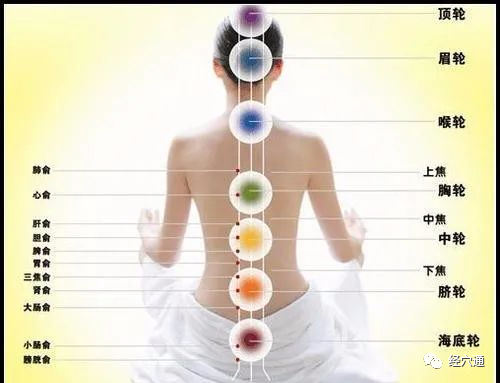
Introduction: Beyond the twelve regular meridians, there are eight extraordinary meridians, known as the qijing bamai (奇经八脉). These meridians play a crucial role in connecting, maintaining, and regulating the twelve meridians, and are of great importance in Daoist health cultivation practices. Understanding these meridians can help enhance the practice of tapping techniques.

The qijing bamai consists of the Ren Mai (任脉), Du Mai (督脉), Chong Mai (冲脉), Da Mai (带脉), Yin Qiao Mai (阴跷脉), Yang Qiao Mai (阳跷脉), Yin Wei Mai (阴维脉), and Yang Wei Mai (阳维脉). Unlike the twelve regular meridians, they do not directly connect to the organs and do not have a paired relationship, hence they are termed extraordinary meridians. Their primary function is to connect the twelve meridians and regulate the flow of qi and blood.
1. Du Mai
The Du Mai runs along the midline of the back, where it frequently intersects with the three Yang meridians of the hands and feet, as well as the Yang Wei Mai. It governs all Yang meridians in the body, hence it is referred to as the “Sea of Yang Meridians.” The Du Mai travels up the spine, enters the brain, and branches out to the kidneys, establishing a close connection with the brain, spinal cord, and kidneys.
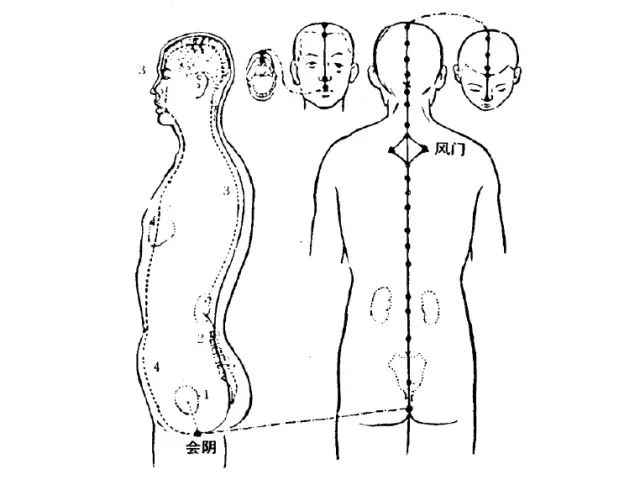
1) Pathway: The Du Mai originates in the lower abdomen, exits at the perineum, travels backward to the Changqiang (长强) point at the tailbone, ascends along the spine, passes through the neck to the Fengfu (风府) point, enters the brain, follows the midline of the head to the Baihui (百会) point at the crown, descends through the forehead to the Suli (素寥) point at the tip of the nose, crosses the philtrum, and reaches the Yinjiao (龈交) point at the center of the upper gums.
2) Branches:
The first branch originates with the Chong Mai and Ren Mai from the uterus, exits at the perineum, and merges with the Foot Shaoyin Kidney Meridian and Foot Taiyang Bladder Meridian at the tailbone, connecting to the kidneys.
The second branch ascends directly from the lower abdomen through the navel, travels upward to the throat, intersects with the Chong Mai and Ren Mai, and encircles the lips, reaching the center below the eyes.
The third branch starts at the inner canthus of the eye, ascends to the forehead, meets at the crown, connects to the brain, and then branches down the back of the neck, along the inner scapula, and the sides of the spine, reaching the lumbar region and entering the muscles on either side of the spine, linking to the kidneys.
3) Physiological Functions:
1) Regulates Yang meridian qi and blood, serving as the “Sea of Yang Meridians”: The Du Mai runs along the back, which is Yang, indicating its role in overseeing and regulating the qi of all Yang meridians. Additionally, the six Yang meridians converge at the Dazhui (大椎) point, allowing the Du Mai to regulate the Yang meridians, hence the saying “governs all Yang meridians in the body.”
2) Reflects the functions of the brain, kidneys, and spinal cord: The Du Mai is associated with the brain and connects to the kidneys. The kidneys produce marrow, and the brain is considered the sea of marrow. The relationship between the Du Mai, brain, kidneys, and spinal cord is very close.
3) Governs reproductive functions: The Du Mai connects to the kidneys, which are responsible for reproduction, thus it is related to reproductive functions.
4) Key Acupoint: Houxi (后溪)
The Houxi point governs the Du Mai and can treat issues related to it, such as neck and shoulder problems, lumbar disc disease, spinal pain, and other symptoms. How to locate the Houxi point? Make a fist, and the point is located at the distal end of the transverse wrist crease behind the fifth finger joint (the end of the transverse crease when the fist is clenched).

We can regularly tap the Houxi point with both hands or place the Houxi area on the edge of a table and gently roll back and forth using the wrist joint to stimulate it. During tapping or rolling, a slight soreness may be felt. Spending just three to five minutes daily on this can significantly benefit the cervical and lumbar spine.
2. Ren Mai
The Ren Mai runs along the midline of the abdomen, where it frequently intersects with the three Yin meridians of the hands and feet, thus it governs all Yin meridians in the body, hence it is referred to as the “Sea of Yin Meridians.” The Ren Mai originates in the uterus and is related to women’s pregnancy, hence the saying “Ren governs the uterus.”

1) Pathway: The Ren Mai starts in the uterus, exits at the perineum, travels through the Yinfu (阴阜), ascends along the midline of the abdomen, passes through the throat (at the Tiantu point), reaches the lower lip, divides to encircle the lips, intersects with the Du Mai at the Yinjiao point, and then ascends to the lower eye socket (at the Chengqi point), connecting with the Foot Yangming Meridian.
2) Branches: It runs from the uterus along the spine, ascending along the back.
3) Physiological Functions:
1) Regulates Yin meridian qi and blood, serving as the “Sea of Yin Meridians”: The Ren Mai runs along the midline of the abdomen, which is Yin, indicating its role in overseeing and regulating the qi of all Yin meridians. Additionally, the three Yin meridians intersect with the Ren Mai, allowing it to regulate Yin meridian qi and blood, hence the saying “governs all Yin meridians.”
2) Regulates menstruation and supports fetal development: The Ren Mai originates in the uterus, playing a role in regulating menstruation and promoting women’s reproductive functions, hence the saying “Ren governs the uterus.”
4) Key Acupoint: Liekui (列缺)
The Liekui point governs the Ren Mai and can regulate its qi, thus treating disorders of the Ren Mai. The Liekui point is easily located, situated 1.5 cun above the wrist crease on the radial side of the radius. To locate it, cross the thumbs, and the depression where the fingertips touch is the point.
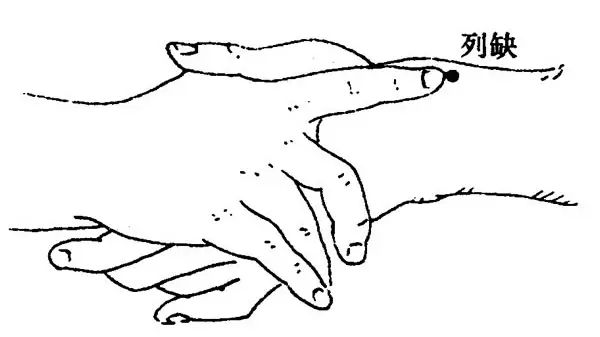
Moreover, the Huangdi Neijing records that the Liekui point primarily treats migraines, headaches, and stiff necks. In the Zhenjiu Dacheng, there is a well-known verse about the four major acupoints, one of which states: “Seek Liekui for neck and head ailments,” indicating that this point can be used to treat and regulate conditions above the neck.
3. Chong Mai
The Chong Mai extends from the head to the feet, traversing the entire body; it serves as a crucial point for qi and blood, regulating the qi and blood of the twelve meridians, hence it is called the “Sea of the Twelve Meridians” and also referred to as the “Blood Sea.” It is related to women’s menstruation.
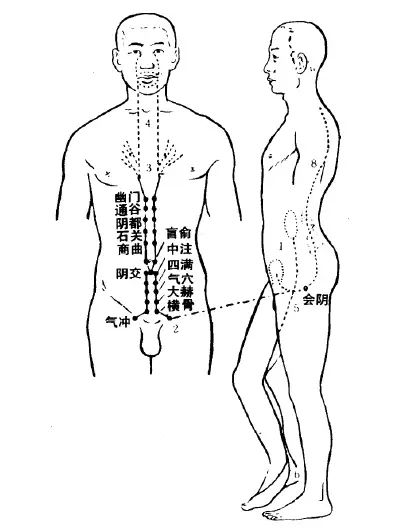
1) Pathway:
It originates in the uterus, exits at the perineum, and divides into two branches. The ascending branch (the main part of the Chong Mai) runs along the anterior abdominal wall, near the navel (5 fen from the navel), ascends, merges with the Foot Shaoyin Meridian, spreads through the chest, ascends through the throat, and encircles the lips; the descending branch runs along the posterior abdominal wall, ascending within the spine.
The descending branch exits at the perineum and descends along the inner thigh to the big toe.
2) Physiological Functions:
1) Regulates the qi and blood of the twelve meridians: The Chong Mai extends from the head to the feet, traversing the entire body, serving as a crucial point for regulating the qi and blood of all meridians. When the qi and blood of the meridians and organs are abundant, the Chong Mai can store and accumulate them; when they are deficient, it can supply and nourish them to maintain the normal physiological activities of the body’s tissues and organs. Thus, it is known as the “Sea of the Twelve Meridians,” “Sea of the Five Zang and Six Fu,” and “Blood Sea.”
2) Governs reproductive functions: The Chong Mai originates in the uterus, also known as the “Blood Chamber” or “Blood Sea.” It plays a role in regulating menstruation. The Chong Mai is closely related to reproductive functions; when the Chong Mai is abundant, menstruation occurs regularly, leading to fertility; when it is deficient, reproductive functions may decline.
3) Regulates the ascending and descending of qi: The Chong Mai connects with the Foot Shaoyin Meridian, belongs to the Yangming Meridian, and connects with the Jueyin Meridian and Taiyang Meridian, thus it has the function of regulating the ascending and descending of qi in certain organs (mainly the liver, kidneys, and stomach).
3) Key Acupoint: Gongsun (公孙)
The Gongsun point governs the Chong Mai, addressing issues related to the stomach and chest. It can effectively treat common conditions such as stomach pain, vomiting, abdominal pain, diarrhea, dysentery, anxiety, insomnia, and counterflow qi rising to the heart. The point is located on the inner edge of the foot, beneath the high bone of the fourth and fifth toes; pressing the point until a feeling of soreness or pain is felt indicates the location of the Gongsun point.
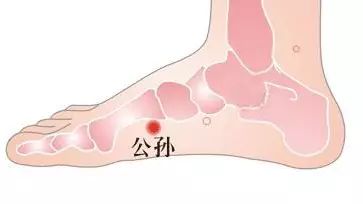
4. Da Mai
The Da Mai originates at the lateral costal region, descending obliquely to the Da Mai point, encircling the body like a belt, and can restrain the meridians that run vertically.
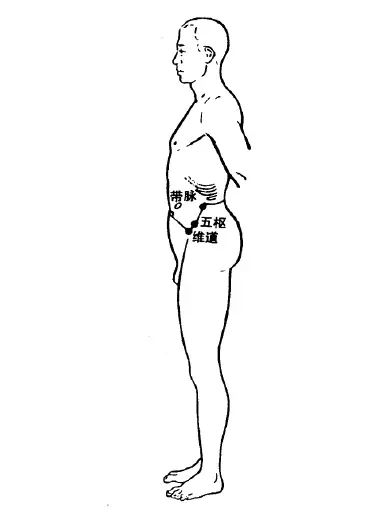
1) Pathway: The Da Mai originates at the fourteenth vertebra, at the lateral costal region, descends obliquely, intersects with the Foot Shaoyang Gallbladder Meridian at the Da Mai point, encircles the body, and then descends obliquely along the upper edge of the hip bone to the lower abdomen.
2) Physiological Functions: It restrains the vertical meridians and governs women’s discharge.
3) Key Acupoint: Zulinqi (足临泣)
The Zulinqi point governs the Da Mai, which encircles the navel, acting like a jade belt around the body, restraining the vertical meridians and enhancing the connection of qi and blood flow between the meridians. It is a very important health meridian for the body. Therefore, the Zulinqi point can effectively treat women’s gynecological issues, waist pain, and can also promote the Yang qi of the body.

The Zulinqi point is located on the outer side of the foot, in the gap between the fourth and fifth metatarsal bones, and can be stimulated by tapping the dorsum of the foot.
5. Yin Qiao Mai
The Yin Qiao Mai runs from the feet to the head, located on the Yin side of the body, and has the function of nourishing the eyes, controlling the opening and closing of the eyelids, and facilitating lower limb movement.
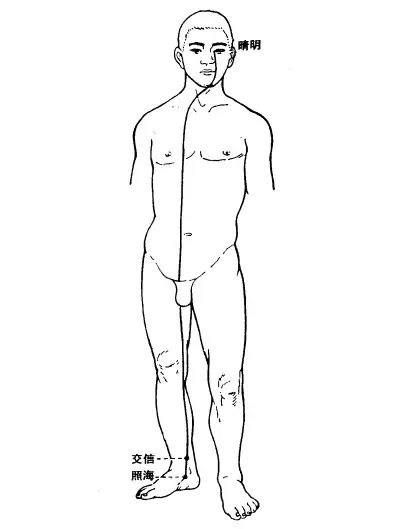
1) Pathway: The Yin Qiao Mai originates at the inner side of the heel, at the Zhaohai (照海) point of the Foot Shaoyin Meridian, ascends along the inner ankle, travels up the inner thigh to the anterior perineum, ascends along the abdominal front, reaches the chest, enters the Jueyin (缺盆) area, ascends to the throat, and reaches the side of the nose, connecting with the inner canthus of the eye, merging with the Foot Taiyang Meridian and Yang Qiao Mai to ascend.
2) Physiological Functions: It controls the opening and closing of the eyes and muscle movements.
3) Key Acupoint: Zhaohai (照海)
The Zhaohai point is an important acupoint for treating throat issues, as it governs the Yin Qiao Mai and intersects with the Foot Shaoyin Kidney Meridian, being one of the key points for the eight meridians. It has the function of nourishing the kidneys, clearing heat, and regulating the three burners, providing both nourishment and heat-clearing effects.
Sun Simiao in the Qianjin Yaofang referred to this point as “Liu Yin,” indicating that if this point is problematic, it can lead to kidney water deficiency, causing deficiency heat to rise. Therefore, if we feel discomfort in the chest, dryness in the throat, hoarseness, or even chronic pharyngitis, we can press this point, which has the effect of nourishing the kidneys and clearing heat, while also promoting the smooth functioning of the three burners.

To locate the point, align the soles of both feet, and there is a small depression below the inner ankle, which is the location of the point (see the image above). When massaging or tapping this point, one should keep their mouth closed and refrain from speaking, allowing the saliva to accumulate and swallow it down. Generally, after 3 to 5 minutes, one will feel saliva in the throat, and the pain will quickly alleviate. Keeping the mouth closed is to facilitate the upward movement of the saliva to moisten the throat, which is what the ancients referred to as the “swallowing saliva method.” Additionally, the Zhaohai point can stimulate the essence and qi in the kidneys, allowing fluids to rise and moisten the throat, thus alleviating throat pain as the kidney water nourishes the deficiency heat.
6. Yang Qiao Mai
The Yang Qiao Mai runs from the feet to the head, located on the outer side of the body, and also nourishes the eyes, controls the opening and closing of the eyelids, and facilitates lower limb movement.
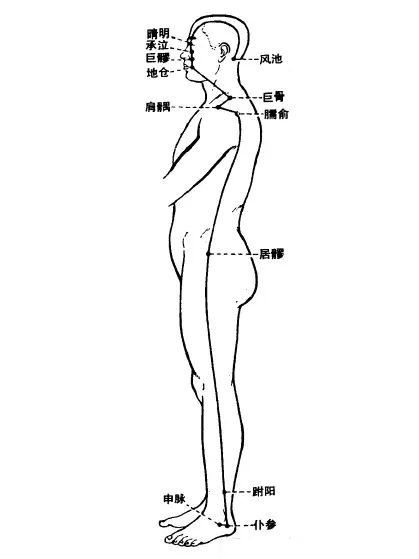
1) Pathway: The Yang Qiao Mai originates at the outer side of the heel, at the Shenmai (申脉) point of the Foot Taiyang Meridian, ascends along the outer ankle, travels up the outer edge of the lower limb to the abdomen, passes through the outer side of the chest, ascends through the shoulder, neck, and reaches the corner of the mouth, finally arriving at the inner canthus of the eye. It merges with the Foot Taiyang Meridian and Yin Qiao Mai, then ascends along the Foot Taiyang Meridian to meet the Foot Shaoyang Meridian at the Fengchi (风池) point behind the neck.
2) Physiological Functions: It controls the opening and closing of the eyes and muscle movements.
3) Key Acupoint: Shenmai (申脉)
The Shenmai point governs the Yang Qiao Mai and is a pure Yang remedy for those with cold body conditions, providing excellent effects for lumbar and leg pain. The Yang Qiao Mai connects to the bladder meridian, and the Shenmai point is an important acupoint of the bladder meridian. Thus, the Shenmai point can dispel internal cold pathogens and promote Yang qi to reach the crown, balancing the body and enhancing agility.
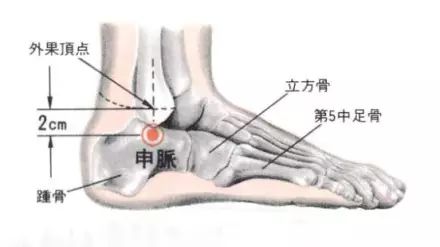
The Shenmai point is a crucial intersection of the Yang Qiao Mai and the Foot Taiyang Meridian, and it is easy to locate, situated in the depression directly below the outer ankle bone. When the body is affected by cold pathogens, it tends to curl up and shiver, which in TCM is referred to as “contraction and retraction.” The Shenmai point has the effect of stretching the meridians, quickly mobilizing the Yang qi in the body, allowing the cold pathogens to disperse as the Yang qi is sufficient, often treated with moxibustion.
7. Yin Wei Mai
The Yin Wei Mai originates at the intersection of the Yin meridians, connecting and regulating them.
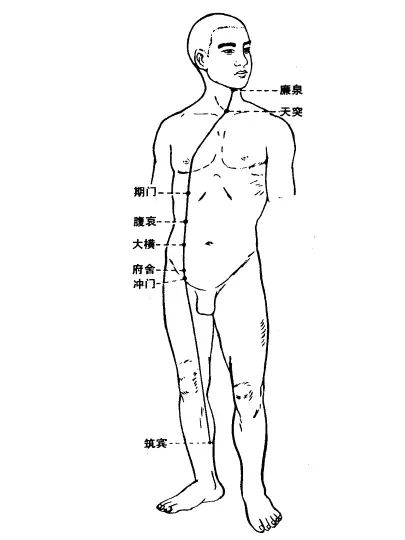
1) Pathway: The Yin Wei Mai starts at the Zhubin (筑宾) point, located five cun above the inner ankle of the Foot Shaoyin Meridian, ascends along the inner edge of the lower limb to the abdomen, travels alongside the Foot Taiyin Spleen Meridian to the lateral costal region, intersects with the Foot Jueyin Liver Meridian, ascends to meet the Tiantu point of the Ren Mai, and terminates at the Lianquan (廉泉) point in the throat.
2) Physiological Functions: The term “Wei” in Wei Mai means to connect and regulate. The Yin Wei Mai serves to connect and regulate the Yin meridians.
3) Key Acupoint: Neiguan (内关)
The Neiguan point belongs to the Pericardium Meridian, connects with the Ren Mai, and intersects with the Yin Wei Mai, governing the Yin Wei Mai. The true efficacy of the Neiguan point lies in its ability to open the body’s internal mechanisms, benefiting qi and blood, calming the spirit, and enhancing beauty. Many women between the ages of 40 and 50 often experience symptoms such as palpitations, shortness of breath, and spontaneous sweating; the Neiguan point can effectively address these issues.
According to ancient texts, women at this age are generally in a stage of decline, with aging beginning from the Yangming Meridian, gradually leading to a decline in the qi and blood of the three Yang meridians. The head is the meeting point of all Yang meridians; when qi and blood cannot reach the face, wrinkles and spots appear. A person’s beauty is closely related to qi and blood. The heart governs the spirit, and its radiance is reflected in the face. The spirit of the heart relies on qi and blood for nourishment; when qi and blood are abundant, it naturally reflects on the face, so women should first nourish the heart to maintain beauty.
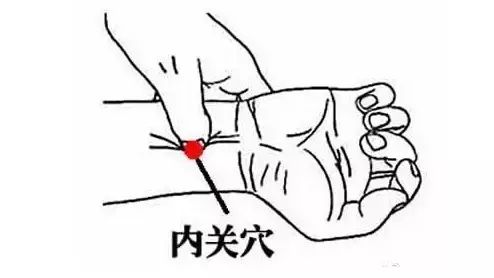
The Neiguan point is also easy to locate, situated on the inner side of the arm, two cun above the wrist crease. To locate it, make a loose fist and place it palm up; align the index, middle, and ring fingers with the wrist crease, and the point where the index finger touches is the Neiguan point. The benefits of this acupoint in health maintenance are that it can be pressed or tapped at any time and place, with a slight feeling of soreness being ideal.
8. Yang Wei Mai
The Yang Wei Mai originates at the intersection of the Yang meridians, connecting and regulating them.
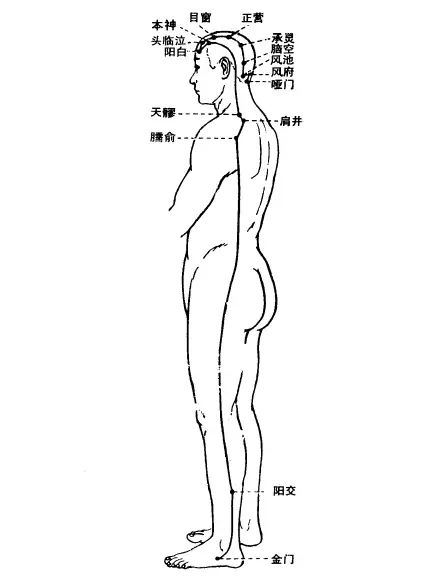
1) Pathway: The Yang Wei Mai starts at the Jinmen (金门) point of the Foot Taiyang Meridian, passes over the outer ankle, ascends alongside the Foot Shaoyang Meridian, travels up the outer edge of the lower limb, through the back outer side of the torso, from the back of the armpit to the shoulder, ascends through the neck, behind the ear, and moves forward to the forehead, distributing along the sides of the head and back of the neck, meeting the Fengfu (风府) point with the Du Mai.
2) Physiological Functions: It connects and regulates the Yang meridians.
3) Key Acupoint: Wai Guan (外关)
The Wai Guan point governs the Yang Wei Mai, connecting all Yang meridians, and has the functions of dispelling wind, relieving pain, and promoting circulation. It is effective for conditions of Yang deficiency, external pain in the chest and ribs, acute lumbar sprains, arthritis, and cervical spondylosis. The Wai Guan point is located 2 cun above the wrist crease on the dorsal side, in the middle between the radius and ulna, opposite the Neiguan point.

Additionally, the Wai Guan point is also known as the “Clever Ear Point.” Traditional Daoist medicine believes that temporary hearing issues are manifestations of Yang deficiency. The Wai Guan point can invigorate the original Yang qi of the three burners and guide the original qi to circulate throughout the body. When this point is blocked, it can lead to the eardrum becoming slack and unable to return to its normal state.
Although the qijing bamai do not belong to the organs and do not have a paired relationship, they further strengthen the connections between the twelve meridians. For instance, the Du Mai governs all Yang meridians, the Ren Mai governs all Yin meridians, the Da Mai restrains the vertical meridians, the two Qiao Mai govern the left and right Yin and Yang, and the two Wei Mai connect the Yin and Yang of the body. Furthermore, when the qi and blood of the twelve meridians and organs are abundant, the qijing bamai can store them, and when the body’s functional activities require it, they can supply and nourish them.
Therefore, clearing the eight major acupoints of the qijing bamai can help adjust and treat their corresponding issues, greatly benefiting health.
Important Note: Due to a major update on WeChat, to avoid losing contact, please click the top of the article “Jingxue Tong > Right Top Corner…” and set it as a Starred item. Thank you!

